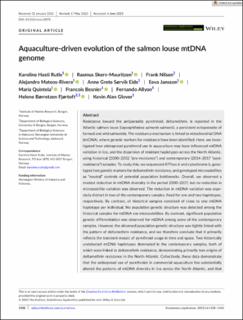| dc.description.abstract | Resistance toward the antiparasitic pyrethroid, deltamethrin, is reported in the Atlantic salmon louse (Lepeophtheirus salmonis salmonis), a persistent ectoparasite of farmed and wild salmonids. The resistance mechanism is linked to mitochondrial DNA (mtDNA), where genetic markers for resistance have been identified. Here, we investigated how widespread pyrethroid use in aquaculture may have influenced mtDNA variation in lice, and the dispersion of resistant haplotypes across the North Atlantic, using historical (2000–2002 “pre-resistance”) and contemporary (2014–2017 “post-resistance”) samples. To study this, we sequenced ATPase 6 and cytochrome b, genotyped two genetic markers for deltamethrin resistance, and genotyped microsatellites as “neutral” controls of potential population bottlenecks. Overall, we observed a modest reduction in mtDNA diversity in the period 2000–2017, but no reduction in microsatellite variation was observed. The reduction in mtDNA variation was especially distinct in two of the contemporary samples, fixed for one and two haplotypes, respectively. By contrast, all historical samples consisted of close to one mtDNA haplotype per individual. No population genetic structure was detected among the historical samples for mtDNA nor microsatellites. By contrast, significant population genetic differentiation was observed for mtDNA among some of the contemporary samples. However, the observed population genetic structure was tightly linked with the pattern of deltamethrin resistance, and we therefore conclude that it primarily reflects the transient mosaic of pyrethroid usage in time and space. Two historically undetected mtDNA haplotypes dominated in the contemporary samples, both of which were linked to deltamethrin resistance, demonstrating primarily two origins of deltamethrin resistance in the North Atlantic. Collectively, these data demonstrate that the widespread use of pyrethroids in commercial aquaculture has substantially altered the patterns of mtDNA diversity in lice across the North Atlantic, and that long-distance dispersion of resistance is rapid due to high level of genetic connectivity that is observed in this species. | en_US |
